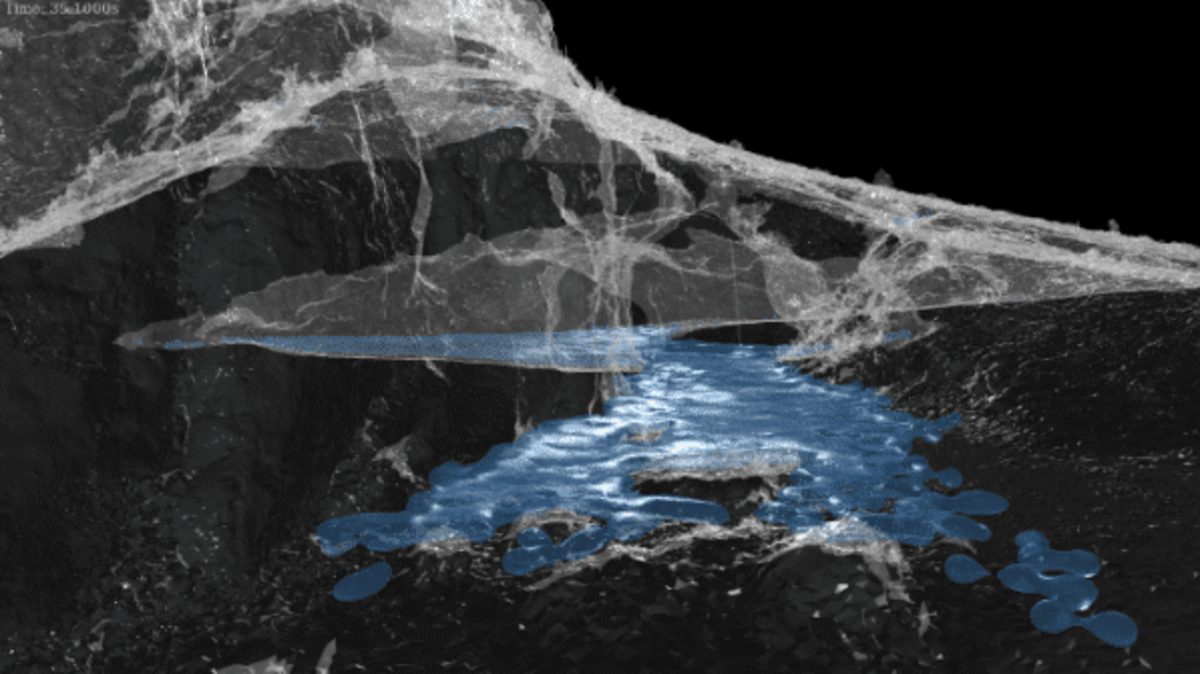Heavy rain at Vogelherd UNESCO World Heritage - on the hunt for new simulation topics

Since we as a company are committed to being ahead of the current state of the art, I am always on the lookout for new topics that can best be linked to calculation topics, but also arouse emotions.
Several years ago, we already dealt with the topic of sprinkler systems, which we also apply very successfully in the area of vehicles and vehicle components.
But what does it look like when heavy rain falls over a longer period of time and we also have very large models, such as building complexes or entire landscapes?
What is currently still calculable and where do we reach our limits?
Just around the corner in the Swabian Alb we have an important UNESCO World Heritage Site, the Vogelherdhöhle.
Here, the first humans created the first works of art of mankind about 40,000 years ago.
As a supporting member of the Ice Age Art Association, it makes sense for me to test a calculation method that not only flushes heavy rain into the cave, but also visitors to the archaeopark. Because it is not easy to keep such a facility alive. So the whole thing is close to my heart, even more so where the mammoth or an enlarged replica lives in my office. (See figure 1)
All the better that Markus and Christoph Steffen from the State Office for the Preservation of Historical Monuments in the Regional Council of Stuttgart have already done preliminary work for us and scanned the whole area in and around the cave.
You can see how the raw data for our virtual sprinkling looks like under the following link. You can virtually walk through the cave there. You can see a screenshot of what that looks like in Figure 2.
But this does not replace the visit on site. So plan your visit when we are allowed outside the door again.
But now back to the actual topic.
The first considerations to represent rain in the simulation we had already almost 10 years ago.
Drops of water fall through a perforated plate into a tub. This is not very spectacular. In the meantime, however, we can easily calculate water crossings of entire vehicles and drive the car through a virtual car wash. No... it doesn't get clean that way!
But a whole landscape? That is another challenge, which already starts with the geometry. How do you get from laser scan data to a computable model?
We don't even need to start with defeaturing, i.e. the suppression of irrelevant components, such as leaves of bushes and trees. Our computational process has to cope with that. Buildings and 3D CAD data, on the other hand, are comparatively trivial.
The next problem is the raindrops. The considered section of the Vogelherd cave has a size of about 50 m x 50 m, such a raindrop is maybe 4-8 mm in diameter. This is ugly, especially for computation times. After all, not very much happens with 10 seconds of rain, 10 minutes or more should do it.
One trick may be to drop much more drops and thus build a time-lapse into the model. But what about accuracy then?
That was the status when we started the project.
What has come out of our calculations now?
The bad news in advance: We can forget about rain with 5 mm drops for 10 minutes, it is possible, but it exceeds our patience and the costs. Here our complete cluster would be currently busy for several months.
Here the pain of answering the question whether the cave dwellers got wet feet or not, and whether it rained into the cave, is just not big enough. At least for us.
So let's approach the issue from a more economic standpoint. The question, what happens if a dam breaks ???? above Vogelherd Cave?
This question was probably not asked by anyone 40,000 years ago. Who should have built the dam and where and why?
But since we can do the math, we just assumed that.
You can see the result in videos 2 and 3.
And there would have been wet feet in this scenario, too. More than half of the cave would have been under water. But presumably no one would have drowned.
While we're on the subject of results and images: I'm always fascinated by what PreonLab's postprocessor can do. Other software developers can take a leaf out of their book. Thanks to Fifty2 for providing the marketing license and for sharing. ????
In the end, we then calculated the results shown here with a particle size of 10 cm, which is sufficient for a quasi-continuum like a pool full of water in this situation. You can get a bit of an estimate of the particle size by looking at Figure 5.
The more particles and the smaller, the longer the calculation time. The calculation time for a few minutes of real time, where most of what happens during a dam break, is 15 minutes here. That sounds much better.
Thus, we can still simulate 3-5 cm particles in reasonable computing times (daily range), for the 5 mm drops, yes, unfortunately we have to wait a few more years according to Moore's law, according to which the computing power of computers doubles every 18 months. But what is that compared to 40,000 years.
So I look forward to welcoming you to the Archaeopark soon.
And yes, share the blog article, maybe I can help attract more people to the park.
Stay calm and healthy! There is also a world after Corona.
Your Stefan Merkle

PS: Here you can find the address:
Visit the Vogelherd Cave in the UNESCO World Heritage Site "Caves and Ice Age Art of the Swabian Alb".
Archaeopark Vogelherd in Niederstotzingen-Stetten
www.archaeopark-vogelherd.de
I can promise you, it is worth it!
PPS: according to current figures, despite Corona also in KW12 the excess mortality in Europe, even in Italy has not increased. On the contrary. See for yourself: https://www.euromomo.eu/
It's a bit alarming when you consider what kind of guns are being brought up. Hopefully it won't be too long before you can visit the Archaeopark.
![[Translate to English:] Wo das Mammut heute wohnt Where the mammoth lives today](/fileadmin/_processed_/3/b/csm_Abbildung-1-Wo-das-Mammut-heute-wohnt_0bbfa26315.jpg)
![[Translate to English:] Virtuelle Begehung, unsere Ausgangsdaten Virtual walk-through, our baseline data.](/fileadmin/_processed_/7/e/csm_Abbildung-2-Virtuelle-Begehung-unsere-Ausgangsdaten_5d9aeff435.jpg)
![[Translate to English:] Röntgenbilder aus dem Computer Röntgenbilder aus dem Computer](/fileadmin/_processed_/f/2/csm_Abbildung-5-R%C3%B6ntgenbilder-aus-dem-Computer-1_9bf7ba0fd2.jpg)
![[Translate to English:] Die Höhlenwelt nach etwas mehr als einer Minute Die Höhlenwelt nach etwas mehr als einer Minute](/fileadmin/_processed_/c/f/csm_Abbildung-4-Die-H%C3%B6hlenwelt-nach-etwas-mehr-als-einer-Minute-1-300x169_d43189c5b5.png)
![[Translate to English:] Die Wahrheit über die Größe der Partikel The truth about the size of particles](/fileadmin/_processed_/0/b/csm_Abbildung-6-Die-Wahrheit-%C3%BCber-die-Gr%C3%B6%C3%9Fe-der-Partikel-1_5d08d94ba7.png)